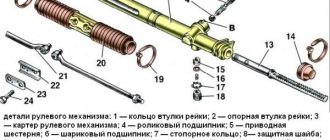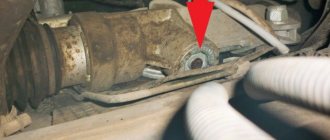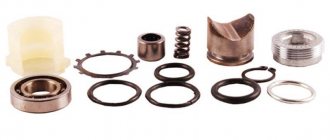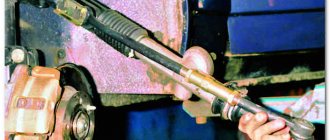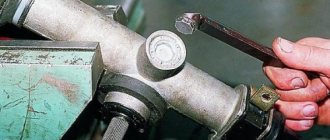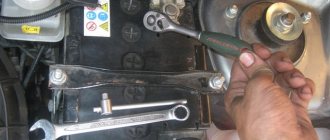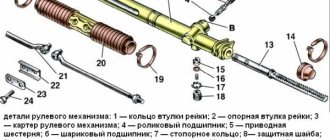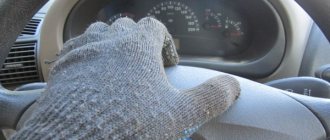How to check the steering rack
The car pulling away from the correct trajectory while driving, increased play in the steering wheel and knocking noise when driving over bumps are typical signs of a faulty steering rack .
However, these same symptoms may indicate wear on the steering shaft or tips, as well as failure of suspension parts - ball joints, silent blocks and wheel bearings. In this article we will tell you how to check the steering rack on a car without removing it, excluding other faults, and how to diagnose a contract steering rack when purchasing to replace a worn one.
Let's summarize
As can be seen from the above, the work is available for self-execution. It is important to purchase a new steering rack for replacement, even if it is a cheap analogue. A good replacement for the factory mechanism would be the following racks: Weber-SG-2108-0012, Trialli-CR-S-708, Trialli-CR-108 or Pilenga-SR-P-1141. These devices are often of decent quality and will last a long time. It is not recommended to purchase refurbished units. Practice shows that they will last from 3 months to six months. For greater confidence in the performance of the device, you can purchase a complete repair kit, which includes bushings, oil seals, anthers and other spare parts.
Source
Signs of a faulty steering rack
The list of steering rack faults varies depending on design features, primarily the presence or absence of power steering. You can read more about all the problems with this unit with power steering, power steering, their symptoms and consequences in the article on steering rack malfunctions. In this article we will highlight the parts most susceptible to failure, the causes of failure and their characteristic symptoms.
| Faulty element | Cause | Symptoms |
| Distributor (for cars with power steering) | Wear of the torsion bar and coil. | Spontaneous turning of the steering wheel or disruption of feedback between it and the wheels. |
| Leaking seals. | The steering wheel turns jerkily or is motionless. Fluid leaks on the body, marks under the car, drop in the level in the power steering reservoir. | |
| Ring wear of the distributor housing. | Increase in fluid level in the power steering reservoir when turning the steering wheel. | |
| Steering shaft with bearing and gear | Corrosion and grinding of gear teeth. |
|
| Bearing damage. | ||
| Toothed rack (“rasp”) | Mechanical wear of teeth. | |
| Rail support bushings | Ellipse or destruction of the bushing. | Minor vibrations in the steering wheel when driving over uneven surfaces. |
| Tie rod joint | Making a hinge or bushing. | |
| Corrosion due to damage to the boot. |
All mechanical malfunctions of steering rack parts, in addition to the listed symptoms, are accompanied by a characteristic knocking sound when driving over uneven surfaces from the engine compartment.
New or refurbished?
Among car enthusiasts, the question often arises regarding the steering rack - should I purchase a new one for replacement or restore the “original” one? It is impossible to answer unequivocally here.
If the repair was carried out independently and using a high-quality repair kit, then after restoration the rack can serve for quite a long time.
But if you purchase a restored rack or if it is repaired at a service station, there is a high probability that problems will soon arise. After all, it is unknown who, how and with what help carried out the restoration.
As for new units, there are a lot of defective racks on the market.
In general, it is still better to try to repair the rack first, since it is much cheaper. It is worth purchasing a new mechanism only after you have already become convinced that the restoration did not help.
How to check the serviceability of the steering rack
Most signs of a bad steering rack coincide with symptoms of wear on other steering and suspension components. The source of the problem can be reliably determined only after removing and disassembling the unit. However, to begin with, it makes sense to conduct a preliminary check of the serviceability of the steering rack on the car, and make sure that this is the problem. This can be done in two ways: check whether the steering rack is knocking and evaluate its play.
Preliminary check of the steering rack without removal in 10 seconds
Quick diagnosis of the steering rack. Visual method: video
To pre-check the steering rack if vibrations or play appear on the steering wheel, you need to check the steering rack for knocking . To do this, just kick the side of the tire of the front wheels of a standing car.
This method allows you to eliminate malfunction of ball joints or silent blocks of the suspension, which cannot be broken under load. If upon impact a characteristic vibration occurs, the rack knocks in the pipe, and a particularly hard knock sounds when speed bumps pass, then most likely the rack parts are worn out.
The procedure for checking the steering rack for serviceability
Checking the steering rack on a lift with an assistant: video
A more thorough diagnosis of the steering rack is carried out in an inspection pit or on a lift. Some operations will require an assistant and a flashlight. A series of sequential actions will make it easy to determine its condition.
First of all, we check the integrity of the steering rod joint boots, making sure there are no breaks. Then we inspect the housing of the rack and distributor (on a car with power steering) for the presence of fluid leaks, indicating a leak.
We ask the assistant to shake the steering wheel left and right, turn it to its extreme positions. If there are extraneous sounds, we try to localize their source.
Checking for backlashes
How to properly tighten the steering rack: video
- From the bottom side, using clamping or adjustable pliers, fix the steering shaft rod entering the steering rack housing. Ask an assistant in the car to move the steering wheel slightly left and right. The presence of play and knocking indicates problems in the steering column or steering wheel mounting. If there is no free movement and extraneous sounds in this position and symptoms appear after releasing the shaft, check the rack parts.
- Ask an assistant to turn the steering wheel to the left, grab the left (in the direction of travel) tie rod closer to the boot with one hand, and with the other feel the hinge under the boot. While rocking the rod in the longitudinal and transverse directions, make sure with your other hand that there is no play in the hinge.
- Move your hand closer to the rack body and rock the shaft. For more convenient access, you can remove the clamp and slide the boot. In this case, the presence of transverse play will indicate destruction of the support bushing, and longitudinal play will indicate damage to the teeth of the rack or steering shaft gear.
You can also feel the play by asking an assistant to shake the hanging wheel of the car wheel, simulating the movement of the steering wheel left and right with a small amplitude. In this case, you must first verify in a similar way that the steering tips and ball joints are in good condition.
REPAIR OF STEERING RACK FOR VAZ 2115
To save money and sometimes nerves, you can repair the mechanism yourself.
Repair materials
You will need:
- Grease for bearings. It is better to use Mobil Grease XHP 222.
- In aerosol packaging Movil.
- White Spirit.
- A can of WD-40.
- Plastic clamps 200 mm x 4 mm – 3 pieces.
- Rags.
Spare parts
- Steering rack repair kit.
- Silent blocks.
- Ends with nuts.
- Steering cover.
Tool for the job
- Set of socket heads with ratchet.
- Hammer.
- Cardan with extension.
- Tip puller.
- Key with internal octagon.
- The key is 22.
- Chisel, up to seven millimeters wide.
How to check a contract steering rack
You should not buy a rack with traces of corrosion.
In many modern cars, the steering rack cannot be repaired and can only be replaced as an assembly. Since the cost of an original spare part can reach 100,000 rubles, car owners often purchase an analogue or a disassembled unit. In this case, the relevant question is: how to check a contract and used steering rack without disassembling before purchasing.
It is difficult to identify all possible faults on a removed steering rack without disassembling and installing it on a car, and it is almost impossible to determine the service life of a used one. However, by some indirect signs, it is possible to identify a unit that has been repaired or is obviously faulty.
Checking a contract or used steering rack is carried out in the following order:
If the rubber boot is damaged, it means moisture and dirt have entered
- We carefully inspect the body. There should be no cracks, dents, welds or other damage. It is also better to avoid purchasing a steering rack with oil leaks if there are other options.
- Check the steering shaft bearing for play. To do this, holding the rod, we try to swing it in different directions - free play of more than 1.5 mm in any direction is unacceptable even for a used one.
- We make sure that there is no wear on the teeth of the shaft and rack. To do this, having fixed the rack, using clamping pliers or another suitable tool, rotate the shaft left and right until it stops. The movement should be smooth and uniform without backlash, biting or extraneous sounds.
- In the rack with power steering we determine the condition of the piston. To do this, we also rotate the shaft using a tool, closing the holes to which the hydraulic drives are connected with our fingers. In a working part, air will come out of one hole and be sucked into the second.
- Checking the bushings. Holding the rack shaft, we swing it perpendicular to the axis relative to the body. There should be no play or knocking. This procedure must be repeated on the left and right sides.
- If the rack is assembled with rods, we also check the hinge connecting them to the rack shaft for play and inspect the boot (if present) for breaks. If possible, remove the boot and also inspect the condition of the shaft underneath it - there should be no traces of corrosion or dirt on it.
Useful Tricks
If the tip nuts are so stuck that they do not want to come off. You can heat them with a gas burner. After which they usually unscrew easily. In the absence of a puller, many use the “sledgehammer” method. That is, they simply knock off the finger. But the impacts caused create vibration in the entire steering mechanism. This leads to accelerated destruction of the slats. Some drivers neglect to measure the tip before removing it. They focus on the number of revolutions. But this is not always reliable. When using a part from another manufacturer, the speed may be either higher or lower. Do not neglect to lubricate threaded connections during assembly. This will prevent the parts from sticking, and next time it will be easier for you to dismantle the tip. Conclusion
. Poor quality roads, coupled with low quality spare parts, make suspension and steering repairs quite a frequent process. Therefore, replacing steering tips on VAZ 2114 and 2115 is familiar to many owners of this model. This work is not too difficult. This repair can be done in any garage. This will require a minimum number of tools.
FAQ
How do problems with the steering rack manifest themselves?
Characteristic signs of a malfunctioning steering column: knocking when driving over uneven surfaces, inadequate behavior of the steering wheel (jamming, play), lack of feedback from the wheels, deviation from the trajectory when moving in a straight line. On cars with power steering, the steering wheel may rotate spontaneously and traces of liquid may appear under the car.
How to quickly check the steering rack without removing it?
For a quick preliminary check of the steering rack, just hit the side of the tire of the wheel of a stationary car. If a characteristic knock is heard, the steering rack or tips are most likely faulty.
How to check a contract steering rack?
You can independently check the contract steering rack visually by making sure there is no damage to the body, as well as by rotating the steering shaft and observing the operation of the mechanism. The condition of the teeth and bushings can be diagnosed only indirectly by the absence of backlash. More reliable diagnostics of contract and used steering racks is possible at a stand in a service station.
How long can you drive with a faulty steering rack?
It depends on the nature of the damage. Wear of the support bushings manifests itself mainly only as extraneous sounds, which does not in any way affect the control. Malfunctions in the hydraulic system, destruction of bearings or wear of the teeth of the worm pair can lead to an increase in the steering play beyond the permissible limit, its uneven rotation and jamming. Driving a car with such a malfunction is dangerous, so at the first sign of a problem, you need to check and repair or replace the steering rack.
Source
STEERING RACK REPAIR
The car is secured against unexpected movement by installing stops under the rear wheels. Pull the handbrake and lock the steering wheel.
Tip: When making repairs, it is better to disconnect the battery terminals to avoid troubles from the knob touching the “+” terminal during operation.
So:
- The front wheels are removed.
- Using a puller, remove the fingers from the lever struts, having first unscrewed the tip nuts.
- After installing the puller, tighten the screw until it stops. When the key is in tension, the finger is knocked out of the lever with a hammer.
- The nuts securing the rack brackets are unscrewed. The bolt on the steering shaft is loosened from inside the passenger compartment.
- Having completed all preliminary operations carefully so as not to damage the splines, using oscillatory movements, the gear shank is disconnected from the steering shaft.
- The entire assembly is pulled out through the right hole in the car body.
Steering mechanism with tie rods
Next, the VAZ 2115 steering rack is directly repaired:
- The structure is clamped in a vice. Use a special brush or a cloth soaked in white spirit to clean all surfaces of the product.
- The steering rods are removed. To do this, unscrew the bolts on the bracket securing them, after bending the “antennae” of the locking plate, using a “22” key.
- The locking and connecting rod plates are removed.
- The tie rods are removed.
- On the right side, the support and retaining ring are removed from the steering gear housing.
- The clamps with which the protective cover is attached are cut off. Disposable parts are made of plastic.
- The protective cover is removed.
- On the left side of the device, the support and protective cap are removed.
- Using a “17” wrench with an octagonal head, the rack stop nut is unscrewed, the part is removed, the spring and the retaining ring are removed.
Removing the nut, spring and retaining ring
The rack stop is knocked out of its socket. To do this, the crankcase hits a wooden stand. For sealing, a rubber ring is mounted in the groove of the stop.
- The seal is removed.
- The gear boot is removed by simply prying it off with a screwdriver.
- The lock washer is removed.
- Use a special 24mm wrench with an octagonal head to unscrew the nut that secures the gear bearing.
- The nut is removed from the shaft.
- Using a “14” wrench, the gear is removed from the crankcase along with the bearing.
Removing the gear with bearing from the housing
- The rack is removed.
- The bushing is removed. To do this, use a screwdriver to pry up the support sleeve, its protrusions should fit into the crankcase holes and the part can be freely removed.
Removing the support sleeve
- A new bushing is installed. To do this, new damping rubber rings are put on it so that the thin parts of the ring are located against the cuts in the bushing. The protrusions of the bushing should fit freely into the crankcase holes.
- Along the edges of the bushing, the rubber rings are cut and the cut off parts are removed.
- The retaining ring is removed from the gear shaft.
- Using a two-jaw puller, the ball bearing is pressed.
Removing the ball bearing
Pressing out the needle bearing is done using a special puller. If it is not there: two holes with a diameter of two millimeters are drilled in the end of the crankcase to allow the needle bearing to exit onto the ring. Through it, the bearing is knocked out of the crankcase.
Pressing out the needle bearing
The crankcase cavity of the structure is washed. The needle bearing is pressed into place using a piece of pipe. After this, the hole is sealed with preparations similar to “cold welding”. Bearings, drive gear and teeth on the rack are generously lubricated with FIOL-1 lubricant.
Advice: Before you start repairing the steering rack, it is better to familiarize yourself with all the operations in the video.
UNIOL-1 lubricant is placed in the cavity, which is located above the nut holding the bearing of the drive gear. The steering rack assembly is assembled in the reverse order. The protective cover is attached and secured with clamps. The rack stop and nut are adjusted so that there is a gap of 0.12 millimeters between them. After adjusting the rack clearance, the stop nut is capped to prevent unwinding.
Signs of a faulty steering rack
Most cars are equipped with hydraulic booster (power steering) or electric power steering (EPS). The main faults of the steering rack are similar in them, but there are also differences, so it makes sense to consider them separately.
Power steering rack malfunctions
Symptoms of a faulty steering rack with power steering are often associated specifically with the hydraulic system - fluid and pump. So, if a hydraulic rack breaks down, the driver will feel:
- Increased effort when turning the steering wheel. In other words, the steering wheel becomes “heavy”, and if you could literally turn it with one finger, now you need to make significant efforts to turn it.
- Regular decrease in power steering fluid level in the expansion tank. This is indicated by a corresponding lamp on the dashboard, fluid leaks under the car or on elements of the engine compartment.
- Knock when driving. It is especially clearly expressed when driving on uneven roads.
- When turning the steering wheel, a strong hum is heard. And the more the steering wheel is turned (no matter in which direction), the louder the noise becomes. Often the hum is accompanied by a slight vibration of the steering wheel.
- After turning the steering wheel, it slowly or does not return to its original position.
- When the car moves straight, the front wheels do not maintain the trajectory, which is why the car “fidgets” along the road.
Electric steering rack malfunctions
Malfunctions of the electric rack are similar to problems with the hydraulic rack, except for fluid leaks. So, when a rack with an EUR fails, it often happens:
- knocking noise when turning the steering wheel;
- biting the steering wheel;
- uneven force on the steering wheel;
- spontaneous rotation of the steering wheel;
- The red steering wheel icon is lit on the instrument panel.
In general, despite the similarity, they are caused by slightly different reasons, which will be discussed below. The main problem in this case is water that gets onto the rod or into the rack control unit.
Manufacturers and prices
There are several manufacturers on the automotive parts market that have proven themselves well. This:
- AvtoVAZ is the official supplier for conveyors, the cost of the set is 650-700 rubles.
- "Track" has about the same cost.
- FINWHALE - cost - 850-950 rubles.
- LEMFORDER – price – no more than 900 rubles per pair.
- “VIS” – 700-750 rubles per set.
These are the steering tips you can find on the VAZ-2114. The price depends on the manufacturer, the quality is almost the same for all. If you operate the car correctly and carefully, then they will serve faithfully for a guaranteed period.
How to determine whether a steering rack is faulty
Many, especially novice, car enthusiasts are interested in the question of how to understand a faulty steering rack? In most cases, this can be done directly while driving a car, however, wear of the bushing or wear in the body is diagnosed only during removal or disassembly. You can also identify a malfunction using the symptoms described above.
How to check the steering rack for malfunction and what to do
Diagnosis of a steering rack malfunction must be performed based on the symptoms that appear during operation. To begin with, we will describe the diagnostics of the power steering rack.
Noise when turning
If you hear a hum when the steering wheel is turned to its extreme (or close to it) position, it means that you need to check the condition of the hydraulic or electric booster and the components of its working system. In this case, a hum may occur even if the fluid level is normal. You need to check the condition of the pump blades (often, over time, the pump’s performance decreases), the condition of its bearings, and the tension of the drive belt.
Power steering fluid leak
Regular leakage is a reason to check the power steering system and its seals. In particular, if the car owner is forced to frequently add fluid to the system’s expansion tank. In this case, a concomitant symptom of a faulty steering rack will be a fluid leak from the line. It can drain directly onto the ground under the car (usually right under the expansion tank) or streaks can be seen on the steering linkage boots.
Often, when a liquid leaks, air enters the system (the system is “aired”). It can be seen by the bubbling liquid in the expansion tank. As stated above, the cause of the leak may be rust on the rack. To get rid of it in the future, it is advisable to use non-standard plastic clamps to tighten the anthers, and their metal counterparts, which provide a higher level of tightness.
Knock when driving in the front axle
In fact, such a knock may also indicate a malfunction in the vehicle’s chassis, so additional diagnostics must be performed. The knock can be either in the center or on the left or right side. In the best case, a knock may indicate a torn traction boot; in the worst case, it can indicate problems with the rods, levers or other elements.
To understand exactly why such a malfunction occurred, it is better to remove and disassemble the rack. After all, the most harmless thing may be a loose adjusting nut or wear of the bushing (when there is a knock on the right), but a more serious problem is wear of the worm pair.
Torn boot on traction
When checking the performance of the rack, it is necessary to pay attention to the integrity of the traction boot. Ideally, it should be intact and the rubber should be elastic. If it is torn and dirt has gotten inside, it must be replaced, lubricant must be added after removing dirt, moisture, and debris from the mechanisms.
Electric power steering rack
To localize faults in the electric steering rack, it is necessary to check the following elements.
Broken bushings
Most often, the cause of a hum and/or rattling of the steering wheel when turning (and even without it) is broken bushings. Accordingly, it is necessary to carry out dismantling work and check their condition. Usually they cannot be restored. Therefore, you can do it in two ways - change the electric amplifier along with the rack assembly, or buy and use a repair kit, including bushings.
At the same time, it makes sense to check the condition of the worm gear (gear). It fails much less frequently, however, if the car has a high mileage, it is definitely worth checking it.
Turn sensors
The operation of torque sensors is checked using computer diagnostics. Here it is advisable to seek help from a car service center. But, as a rule, sensors are quite reliable devices, so they rarely fail. such a sensor begins to “fail” if the boot that is installed above it is damaged and moisture gets inside.
Electric steering
In modern VAZs with electric power steering, with significant mileage, problems with the electric motor may occur. This can be felt by the increasing force on the steering wheel. Accordingly, in this case it is advisable to check the condition of the brushes, bearings and windings of the electric motor.
Similarly, as when checking a hydraulic rack, you need to pay attention to the condition of the boot, tips, and rods.
Lift
If knocking is detected in the steering wheel, it can be tightened, but tightening will be effective only if there is knocking from the worm gear. If the knocking noise comes from a broken plastic bushing, then tightening is useless.
As is known from practice, the worm mechanism is quite reliable and is very rarely the culprit of knocking. Most often the bushing is to blame.
You can determine the culprit of the knock by pulling the steering rods one by one.
- If there is a knocking sound when applying forces to the right link, then the bushing is to blame.
- If there is a knocking sound when you apply force to the left linkage, then the worm gear is to blame.
In the first case, a lift is not advisable. Since the tightening nut only tightens the worm mechanism. To eliminate the knocking noise, it is necessary to remove the steering rack from the car and have it repaired.
Consequences of a faulty steering rack
Drivers are also often interested in the question of what causes a faulty steering rack, and can it be used in this condition? And to understand the consequences, it is enough to know the function of the steering rack.
That is, the first thing that threatens the failure of the rack is impaired control of the car. And if at the initial stage (when the rack just started to creak and/or hum) it still performs its functions, then if it completely fails, the driver may completely lose control of the car!
HOW TO ELIMINATE STEERING RACK PLAY
While the car is moving, there are times when the driver feels a slight kickback when the car hits a pothole or a small obstacle on the road, in the steering wheel, and a knock appears in the mechanism. Then there is a need to fix the problem. In this case, VAZ does not require repair of the steering rack, but only adjusts the gap formed between the rack and gear. Why are there special instructions? To perform the work, it is better to install the car on an inspection hole, a special lift or overpass.
Work order
- If there is protection on the crankcase, it can be removed.
- Using a special 17 mm wrench, turning clockwise, the adjusting nut is tightened until the play in the rack gearbox is eliminated.
Eliminating play in the steering rack
Tip: Before tightening the nut, you need to thoroughly clean it of dirt.
If such an operation does not eliminate the knocking, you need to disassemble the steering mechanism, check the condition of all its parts, and replace worn elements with new ones. The cost of such repairs will be higher.
- Then, after assembling the steering gear assembly, the rack stop, which has an O-ring, is installed until the stop makes contact with the rack.
- After this, the retaining ring and thrust spring are installed and the nut is lightly screwed on.
- The nut is tightened with a torque equal to 1.12 - 1.37 kgf.m, the two divisions marked on the nut or on the 24 wrench are released, which provides the required gap of 0.12 millimeters, from the nut to the stop of the rack.
- The ease with which the rack moves is checked, the absence of knocks or jamming.
- The steering rods are mounted to the steering mechanism in such a way that their axes should be parallel to the steering mechanism housing.
The play is eliminated, but the knocking does not stop, then one of the options is chosen: buy a new steering rack or repair the steering rack on the VAZ 2115, which is much cheaper.
